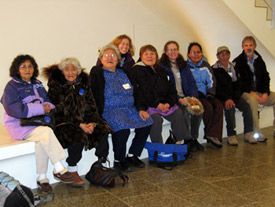Anaktuvuk Pass

View toward Anaktuvuk Pass nestled in the mountains of the Brooks Range. Courtesy of the National Park Service.
Anaktuvuk Pass, at 2,200 feet elevation on the divide between the Anaktuvuk and John Rivers in the central Brooks Range, is the last remaining settlement of the Nunamiut (inland northern Inupiat Eskimo). Traditionally, the Nunamiut were a nomadic people who moved from camp to camp following the caribou herds.

Elders from Anaktuvuk Pass in the lobby of the University of Alaska Museum of the North, November 5, 2008.
In 1949, groups settled in the Anaktuvuk Pass area in order to have more regular access to school and the post office. The city was incorporated in 1959, but also is under the jurisdiction of the North Slope Borough, and has a federally recognized tribe. The estimated population in 2011 was 325. The community remains dependent upon subsistence activities, and has a strong arts and crafts industry where residents are particularly known for their finely-crafted caribou skin and fur-trimmed masks.

Elders Doris Hugo (left) and Rhoda Ahgook (right) look at Simon Paneak’s journal with staff members Caroline Atuk Derrick and William Schneider in the Alaska Polar Regions Collections and Archives, Elmer E. Rasmuson Library, November 4, 2008.
Elders from Anaktuvuk Pass visited the University of Alaska Fairbanks on November 3-7, 2008 to look at collections and decide what they most wanted to have accessible online. Rhoda Ahgook, Rachel Riley, Doris Hugo, Thomas Rulland, Ada Lincoln, and Vera Woods looked at the writings of Nunamiut elder, Simon Paneak, in the Ethel Ross-Oliver and the Lawrence Irving Collections and photos in the George Llano Collection in the Alaska and Polar Regions Collections and Archives, Elmer E. Rasmuson Library.
They watched film of the 1973 Alaska National Interest Lands Conservation Act (ANILCA) D-2 Land Hearings from the Alaska Film Archives, and looked at caribou skin masks, snowshoes, and caribou skin pants and boots at the University of Alaska Museum of the North. They reviewed Native language material at the Alaska Native Language Archive, and looked at the collection of northern archeologist, Jack Campbell, held in the archives at the Gates of the Arctic National Park headquarters. Several of these collections are now available online and accessible through this portal.

